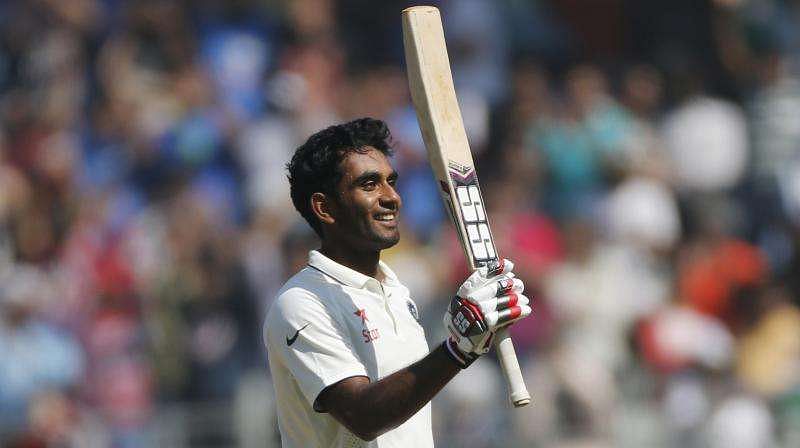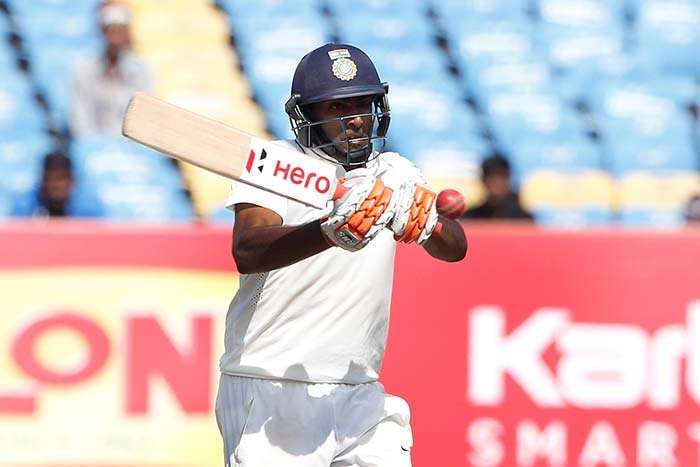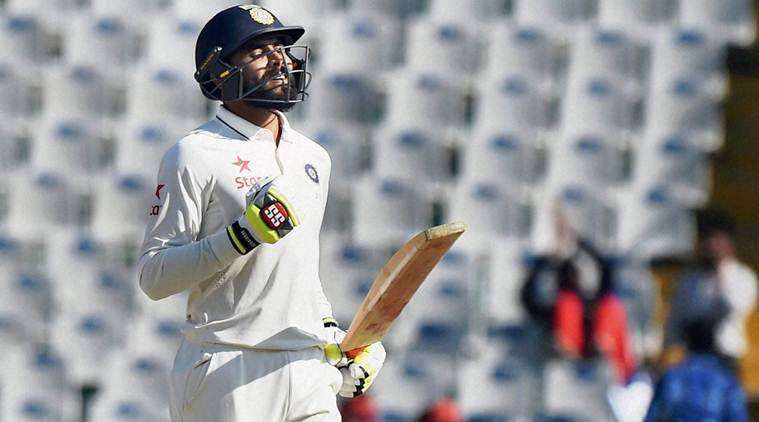
Is this India's best tail order ever?
When Virat Kohli fell to Ben Stokes on Day 2 of the Mohali Test, England would have felt quite relieved. The English had fought back bravely to nip six Indian wickets on the second day for a score of only 204. India still trailed England by 79 in their first Innings, and the visitors’ ignominy of having nearly been bowled out on the first day after choosing to bat, was all forgotten. Or so they thought.
The visitors had their tails up, and it was clear that India was staring down the barrel. Ravichandran Ashwin, perhaps, was the only one expected to wage a lone battle to get India as close to England’s first innings total as possible. Jadeja’s batting had blown more cold than hot; Jayant Yadav was only just finding his feet in international cricket; the two pacers would surely wield the long handle without putting a price on their wickets.
Instead, India’s tail wagged harder than it had ever before in all their 500+ Test matches. Just when England seemed to be on top and in a position to force a win, India’s lower order smacked them right in the face when they weren’t looking. Often have pundits said, that great teams are characterised by lower orders that show a fighting spirit and never more had that attribute been displayed by India’s tail.
Despite losing Kohli at 204, India waltzed to 417, with half-centuries from Ashwin, Jadeja and debutant Jayant Yadav. The tail added a staggering 213 runs after Kohli’s dismissal. It was indeed an unprecedented achievement but there was more to come. Had anyone suggested, at that point, that the best was yet to come from India’s tail, scarcely anyone would have believed it.
India’s lower order has stepped up with the bat
In the first Test at Rajkot, India were left tender at 361 for 6 on the fourth morning, chasing their tails after England amassed 537. Ashwin orchestrated the rescue act there, adding 127 runs with the rest of the bowlers for company.
India still conceded a 49-run lead, but if not for that rearguard action, India would have surely lost the Test with time to spare.
While the pitch had something more in it for the bowlers in the second Test at Vizag, India were left vulnerable on the second morning, with Kohli’s dismissal at 351 exposing the tail. Once again, on a surface that was taking turn significantly more than at Rajkot, the tail cobbled together 104, with debutant Jayant Yadav impressing on debut.
Once again, that contribution changed the complexion of the match, as England conceded a 200 run lead. Despite India getting only 204 in their second innings, that crucial lead allowed the hosts to set a daunting 405 run target. On a pitch that had deteriorated considerably by the fifth day, it was too much to ask of England.
An assured look
Progressively, India’s tail looked more assured and confident, even in the face of good quality bowling from the English bowlers. Ashwin only added to the prevalent belief (as confirmed by the ICC rankings) as being India’s best all-rounder since Kapil Dev. In Mohali, Jadeja finally came good with an attacking 90, but the true find of the series was Jayant Yadav.
Playing in his first Test, Jayant scored 35 and an unbeaten 27 at Vizag before notching up his first half-century, a carefully constructed 55 at Mohali. Each time he stepped onto the field with bat in hand, he looked assured and at home in the international arena. Despite already impressing in his first three innings, the best from him was yet to come.
When the going gets tough
India’s tail produced their best right when it was needed the most. After winning the toss and misfiring with only 283 in Mohali, England were determined not to repeat that mistake in Mumbai. With another impressive debutant, Keaton Jennings, coming good at the top of the order for England, they managed to gather 400 runs. Finally, it seemed like the visitors would be able to exert some pressure on the Indian batting lineup like they had done in Rajkot.
Their plan even seemed to work. While India played out the last session on the second day to reach 146 for the loss of KL Rahul, the third day was where the test would be decided. To the second ball of the third morning, Pujara fell. Despite Vijay getting a hundred and Kohli holding fort at one end throughout the day, India lost wickets regularly.
The hosts were found wanting in the second session in spite of Kohli posting a half-century. In the space of 45 runs, India had lost 4 wickets. When Jadeja entered at 307/6, India desperately needed Kohli to continue his presence at the crease. Jadeja counter-attacked, taking some pressure off Kohli, but was dismissed with the score reading 364.
India ended the day well, all thanks to its captain, who remained unbeaten on 147 and had helped India secure an important 51 run lead. What transpired the next morning, though, is the stuff of legends. From his overnight score of 30, Jayant Yadav launched his way to his maiden Test hundred. His crisp stroke play and assured defence reiterating why Haryana play him at number 4.
How does this tail compare?
In the three matches that Jayant Yadav has featured in, India’s tail has performed wonderfully. Others who galvanised the performance of the lower order (number 7 and lower), include R Ashwin, MS Dhoni, and above everyone else, Kapil Dev.
Even tails involving Dhoni and Kapil rarely produced the kind of numbers that Mohali and Mumbai threw up. One thing in favour of the lower order involving Jayant is that all their matches have been played at home.
| Players | Matches | Runs | Average | 100s | 50s |
| Ashwin, Jadeja and Jayant | 3 | 427 | 38.81 | 1 | 3 |
| Dhoni, Harbhajan Singh and Anil Kumble | 18 | 1785 | 28.79 | 0 | 13 |
| Ashwin, Jadeja and Bhuvneshwar Kumar | 8 | 659 | 23.53 | 2 | 2 |
| Kapil Dev, Syed Kirmani and Roger Binny | 20 | 1959 | 25.11 | 0 | 8 |
| Kapil Dev, Syed Kirmani and Madan Lal | 22 | 2287 | 29.70 | 2 | 15 |
| Kapil Dev, Syed Kirmani and Karsan Ghavri | 24 | 1973 | 24.35 | 0 | 7 |
| Kapil Dev, Kiran More and Manoj Prabhakar | 25 | 2286 | 28.93 | 2 | 13 |
While Ashwin, Jadeja and Jayant have produced astounding numbers, they have only played three matches together and that leaves a lot to be desired. No other lower order has even come close to their numbers.
However, some other points emerge from a study of the numbers – all of the best Indian tail orders have involved either Ashwin, Dhoni or Kapil. Another thing that is clear is the impact Kapil Dev had on the lower order. While comparisons between Ashwin and Kapil Dev might gain currency in the future, the former will have to make an immense contribution going forward to be even considered in the same league as the latter.
India’s best lower order ever?
If in Rajkot India’s tail had saved them embarrassment, in Mumbai they saved India from even having to bat again. Had Kohli run out of partners on his way to a towering 235, India would have run into problems having to bat last on the fifth day. No wonder then, that this appears to be India’s best tail order ever.
No Indian had ever scored a century coming in to bat at number 9 before Jayant Yadav. It speaks volumes of how India’s tail was never expected to be so adept at batting. Traditionally, you get India seven down; you get them all out.
This tail order now gives the Indian Test side a batting depth it has never had before, at least in home conditions. The ability to be incisive with the new ball and old, and at the same time, the ability to add crucial lower-order runs on a good surface or grind out difficult runs on a bowlers paradise. Rarely have these abilities come together for an Indian lower order.
Perhaps no other Indian lower order had established themselves in the First Class circuit as has this bunch. Although Jadeja’s triple hundreds haven’t exactly translated into wonderful performances at the Test level, Jayant and Ashwin look to be decent Test batsmen. It only proves the point that in Indian (and perhaps subcontinent) conditions, India now have a formidable tail.
True test yet to come
The true test of a good Test match player, however, comes away from home. That is where the true test of India’s lower order will come. They have yet to play England, Bangladesh and Australia at home over the next few months. It will now be expected of them to do well over the next six Tests at home. Beyond that, India tours South Africa, England, Australia and New Zealand.
Not only will their batting skills be put to the test in swinging and seaming conditions on bouncy tracks, but also their wicket taking ability. A lower order’s first order of business is picking wickets, and if they are unable to do that, then they don't deserve a place no matter how well they bat. To truly become India’s best lower order ever, these blokes will have to pick wickets and bat in foreign conditions, where the ball will be whizzing past at nose level.
Ashwin might be the world’s best bowler and all-rounder, but his exploits have largely come at home on helpful tracks. Jadeja isn’t even a permanent fixture on away tours, and where Jayant Yadav will fit in on seaming tracks is a question yet to be asked. But for now, India’s tail looks like the horn of plenty.


